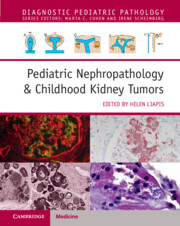Book contents
- Pediatric Nephropathology & Childhood Kidney Tumors
- Diagnostic Pediatric Pathology
- Pediatric Nephropathology & Childhood Kidney Tumors
- Copyright page
- Dedication
- Contents
- Contributors
- Preface
- Section 1 Normal and Abnormal Human Kidney Development
- Section 2 Glomerular Diseases
- Section 3 Tubulointerstitial Diseases
- Chapter 9 Hereditary and Acquired Tubulointerstitial Diseases
- Chapter 10 Tubulointerstitial Diseases with Crystal and Pigment Deposits
- Section 4 Vascular Diseases
- Section 5 Infectious Diseases
- Section 6 Cystic Diseases
- Section 7 Solid Tumors of the Kidney
- Section 8 Transplant Pathology of the Kidney
- Index
- References
Chapter 10 - Tubulointerstitial Diseases with Crystal and Pigment Deposits
from Section 3 - Tubulointerstitial Diseases
Published online by Cambridge University Press: 10 August 2023
- Pediatric Nephropathology & Childhood Kidney Tumors
- Diagnostic Pediatric Pathology
- Pediatric Nephropathology & Childhood Kidney Tumors
- Copyright page
- Dedication
- Contents
- Contributors
- Preface
- Section 1 Normal and Abnormal Human Kidney Development
- Section 2 Glomerular Diseases
- Section 3 Tubulointerstitial Diseases
- Chapter 9 Hereditary and Acquired Tubulointerstitial Diseases
- Chapter 10 Tubulointerstitial Diseases with Crystal and Pigment Deposits
- Section 4 Vascular Diseases
- Section 5 Infectious Diseases
- Section 6 Cystic Diseases
- Section 7 Solid Tumors of the Kidney
- Section 8 Transplant Pathology of the Kidney
- Index
- References
Summary
Tubulointerstitial diseases with crystal and pigment deposits are important histopathological disease entities that occur in pediatric patients and that are associated with acute and chronic kidney injury. Tubulointerstitial diseases with crystal deposits include oxalate nephropathy, nephrocalcinosis and 2,8-dihydroxyadenine (DHA) nephropathy. Tubulointerstitial diseases with pigment deposits include myoglobin cast nephropathy, hemoglobin cast nephropathy, red blood cell casts and bile cast nephropathy.
Although some of these tubulointerstitial diseases may show overlapping histopathological features, it is important to distinguish them as separate entities, since each of them is associated with distinct clinical symptoms, etiologies, therapies and prognosis.
Keywords
- Type
- Chapter
- Information
- Pediatric Nephropathology & Childhood Kidney Tumors , pp. 197 - 212Publisher: Cambridge University PressPrint publication year: 2023

